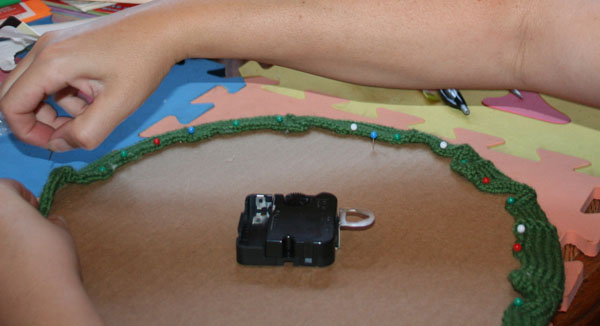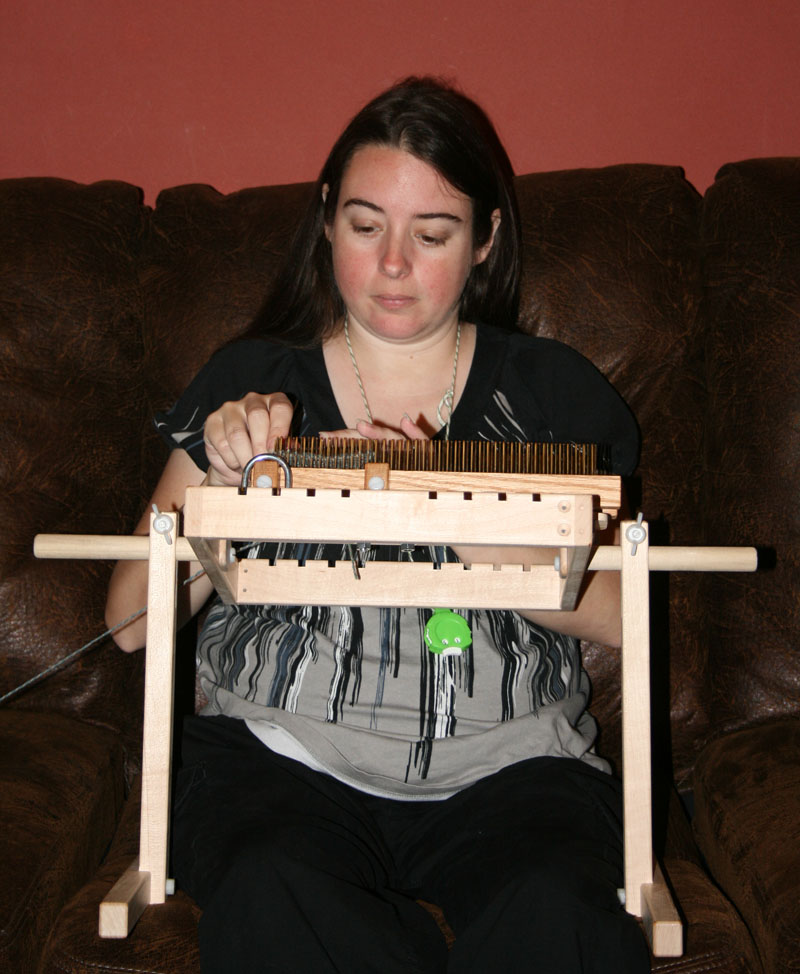Kelly Jones
Time to Knit
Time to Knit
by Kelly Jones © 2012
This unique clock pattern was knit on the fixed 2 loom. It was featured in the Fall 2012 issue of Loom Knitters Circle Magazine.
For more of Kelly's patterns visit: www.kellyknits.com
Loom: Kiss Fixed 2 Long Slim Adjustable Loom
Yarn: Approximately 170 yards of #2 yarn Jo Sharp 100% pure wool 107 yds (2), color Olive
Gauge: 5 st x 8 rows per 1”
Supplies:
12” Cardboard Cake Board (see photo below)
Straight Pins
Hot Glue Gun and Glue
Clock Components (see photo below)
Large Clock Hands (see photo below)
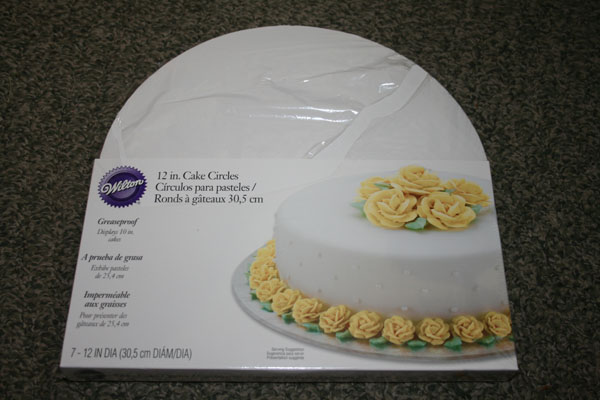
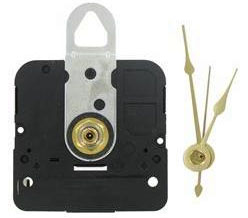
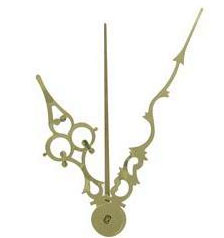
Notes:
1. Consider peg 1 to be on the right hand side after cast on. Peg 33 is on the left.
2. Wrap and turn is completed by lifting loop, wrapping working yarn around peg by going behind to the left hand side of peg and then around to the front of the peg. Place loop back on peg and continue knitting the next row, make sure you are behind the pin! Do not knit off this w&t peg!
3. The return row from the wrap and turn on peg 17 is the only row of purl in each wedge.
4. Clock component kits come in different shaft lengths to accommodate the thickness of your clock face. You may want to measure the width of your knitting once it is glued to the cake board to determine which size kit you need. For this weight yarn I used ¼” thick clock face components.
5. Clock component kits come with small hands that may not be appropriate for the size of your clock. The minute hand should rotate over the top of where the numbers would go. Hand kits are offered separately and come in a variety of sizes and colors. For this diameter clock I used 4 1/8” clock hands.
6. Super Stretchy Bind Off video
If you are wanting to make another size clock, use Isela's Pinwheel Dishcloth “Adapt Me” instructions at the bottom for other diameter circles.
Cast on 33 pegs left to right with a marker on peg 17, this will be the middle stitch with 16 on each side.
*Knit 2 rows using u-wrap stitch
Knit to peg 30 – wrap and turn peg 31. Do not knit off peg 31! Knit to peg 1.
Knit to peg 29 – wrap and turn peg 30. Do not knit off peg 30! Knit to peg 1.
Continue in this manner until you wrap and turn peg 17, purl back to peg 1.
Continue knitting and wrapping and turning until you wrap and turn peg 3 and knit back to peg 1.
On the next row, knit all 33 pegs, lifting 2 loops over one on pegs 3-31. Knit to peg 1*
This completes wedge one. Repeat from * to * for 5 more wedges, a total of 6.

Bind off using super stretchy bind off. Seam to beginning edge making sure to leave a small opening in the center to put clock component shaft. Secure hole by sewing through loops around the edge – do not pull snug.
Bind off method 2:
Knit 5 rows in waste yarn, remove project and graft edges together. Make sure to leave a small opening in the center to put clock component shaft. Secure hole by sewing through loops around the edge – do not pull snug.
If you've used wool for your clock you can add needle felted numbers before blocking. Use strands of contrasting wool yarn and shape the numbers. Pin knitting with wrong side up on blocking board. Use cake board as a template to make sure you block evenly.
Prepare Clock Base:
Punch small hole in center of 12” cake board. Place cake board on knitting – line up center hole in board and knitting. Pin edges to cake board making sure not to misalign center holes.
Check alignment of pattern on front edge of clock to make sure the purled lines are even around clock.
Go back and un-pin small sections and hot glue edge down. Hot glue should dry fast enough to not replace the pins. Allow to dry.
Add Clock Components:
Place clock mechanism through the back of the cake board. Make sure shaft is long enough that the hands will run smoothly around your clock and not snag on the knitting. Add hands – hour hand first, then minute hand and second hand on top. You may choose not to use second hand. You may wish to tape or glue the clock mechanism in place to secure it. I recommend tape so that if you need to replace the mechanism at some point you don't tear up the cake board.
Hang on the wall and enjoy – make time to knit every day!
Cable-Me-Not Dragon Cowl or Scarf
Cable-Me-Not Dragon Cowl or Scarf
By Kathryn Doubrley ©2015
This faux cabled cowl is a fun quick knit that is perfect for those almost last minute gifts. Use a #6 weight yarn on this project with the new Dragon Large Gauge Loom!
For more of Kate's patterns and to download the Cowl:
http://www.theanswerlady.com/kisslooms1.html
Do You Wanna Build a Snowman
Do You Wanna Build a Snowman?
by Kelly Jones © August 2014
This Olaf pattern was created for the Kiss Looms 7th Anniversary party in 2014. I really hope you enjoy him - in summer and winter! Also take a look at this fun video of Olaf - In summer.
Yarn: White – 250 yards (Patons Aran Style Fisherman Knit yarn used in sample – recommended for 7 mm knitting needles 19 sts=4”), Brown for arms (can also be used for eyes, mouth, hair and buttons) – 70 yards (Red Heart Super Saver used in sample), Blue for eyes, mouth, brows, hair and buttons – 25 yards (Red Heart Super Saver Navy used in sample), Orange for nose – 20 yards (Red Heart Super Saver Pumpkin used in sample)
See Notes section at end for techniques and abbreviations
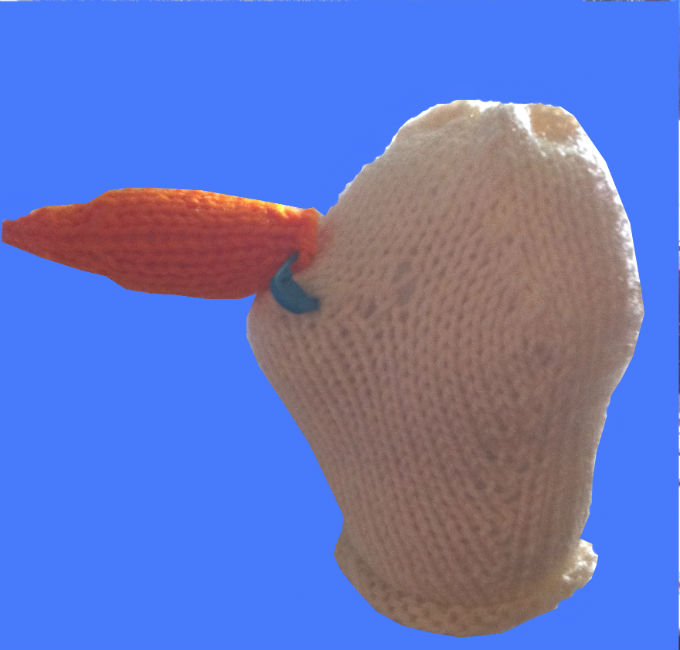
double e-wrap cast on 36 pegs in the round – space these so you are working in the middle of the loom so you can increase on both sides.
Row 23 increase 2 right hand side slider (52 pegs)
yellow pegs will have the wrap and turn
Row 39 knit pegs 5-10 knit 2 over 1 on peg 10
drawstring cast on 4 pegs in the round
double e-wrap cast on 12 pegs left to right
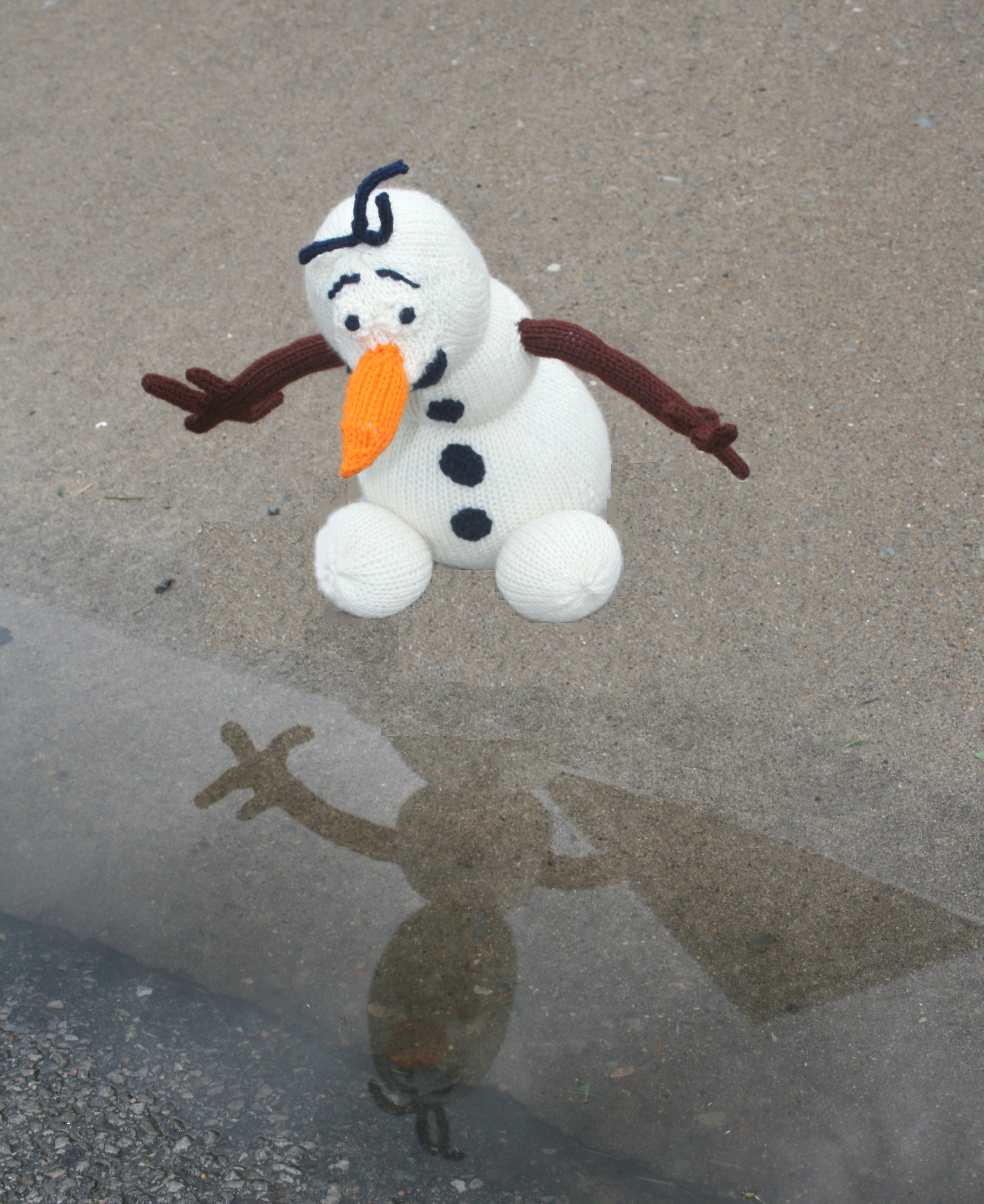
double e-wrap co 5 pegs on peg board only – do not use pins
3 peg i-cord on pegs only till 5” long
CO 3 pegs as flat panel
drawstring co 34 pegs in the round
drawstring co 46 pegs in the round
drawstring co 28 pegs in the round knit 28 rows gather bind off leaving long tail for seaming to large body
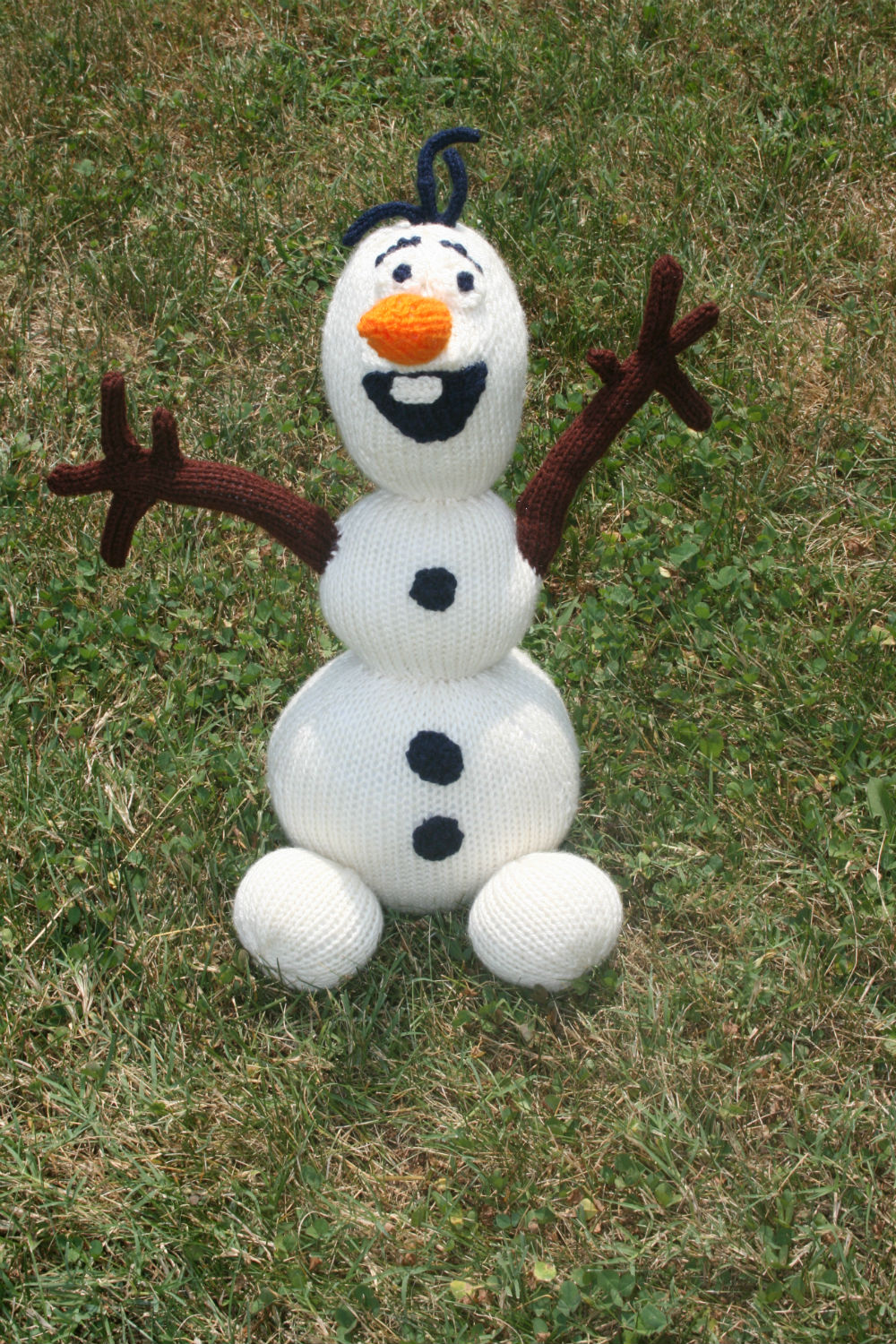
double e-wrap co 10 pegs in the round
double e-wrap co 4 peg icord with pins
Large Fingers (make 4)
double e-wrap co 6 pegs
CO 3 pegs as flat panel
CO 4 pegs as flat panel
You may want to do some assembly as you go along. It's a lot more fun this way and you can make sure none of the parts wander off.
Eyebrows – Stitch the eyebrows in place using the back stitch method described in the notes section.
Hair – Take the longer strand of hair and fold it into 2” and 3” sections. Stitch down to top of head with the 3” section in the middle. Place the 2” strand close to the base of the 3” tall section and seam in place.
Arms – Stitch the large fingers on either side of the single finger on the arm. It's ok if this flattens it out a bit – this will form a bit of a palm for him. Just try not to seam all the way through to the other side. The fingers are not stuffed! Stitch the small finger on the top edge of the arm. Stuff the arm till it can stand out straight and not be floppy. Seam to the small body.
Buttons – Stitch in place, 1 on the small body and two on the large body.
Abbreviations:
K- knit with the u-wrap stitch unless otherwise noted
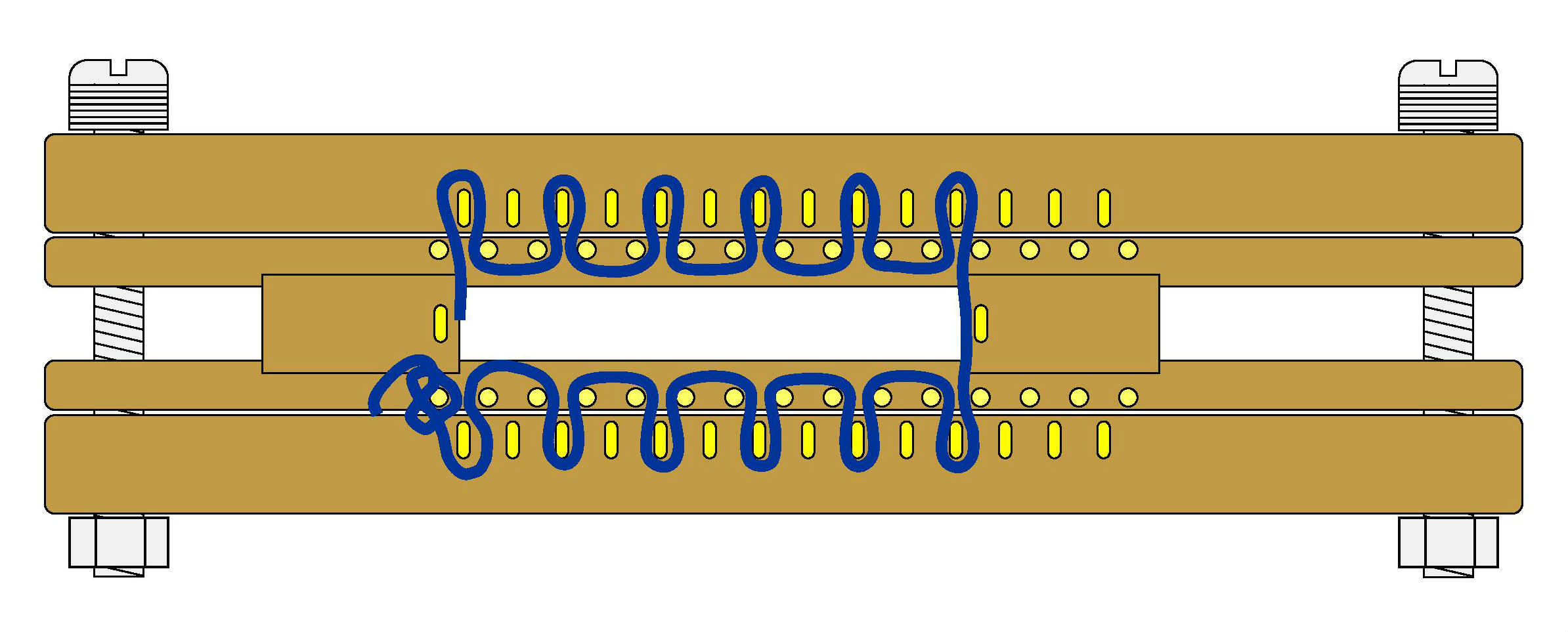
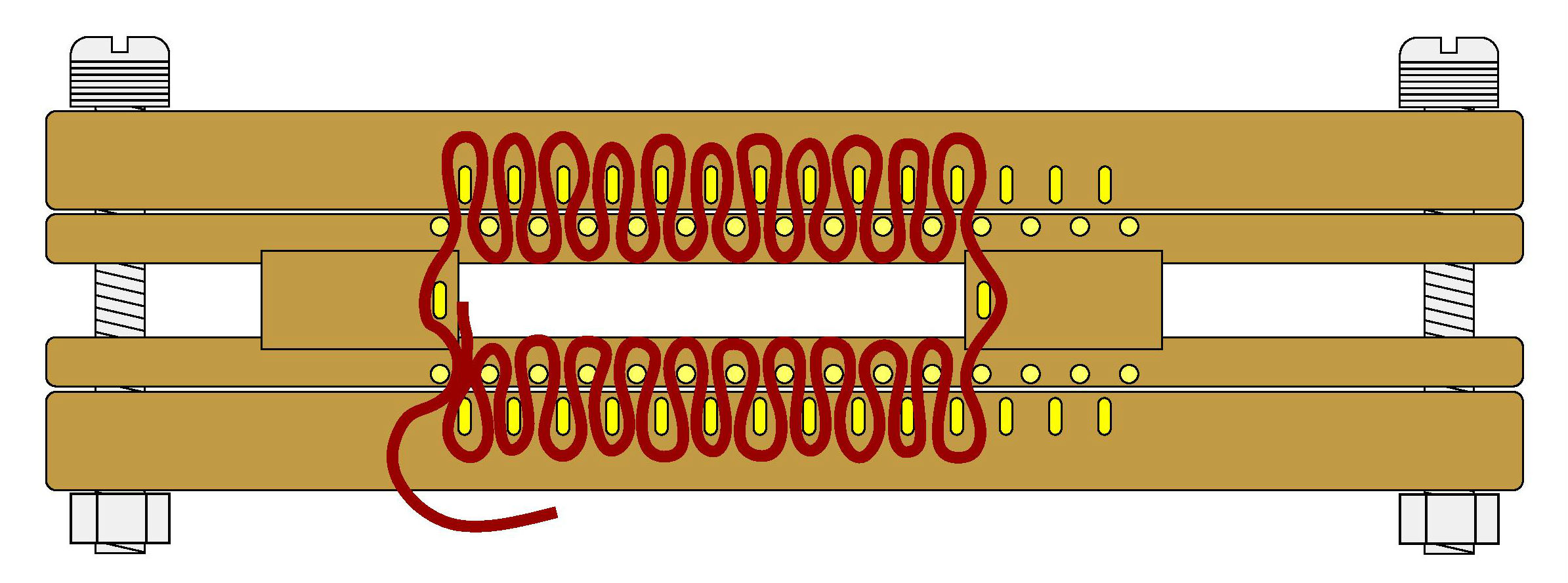
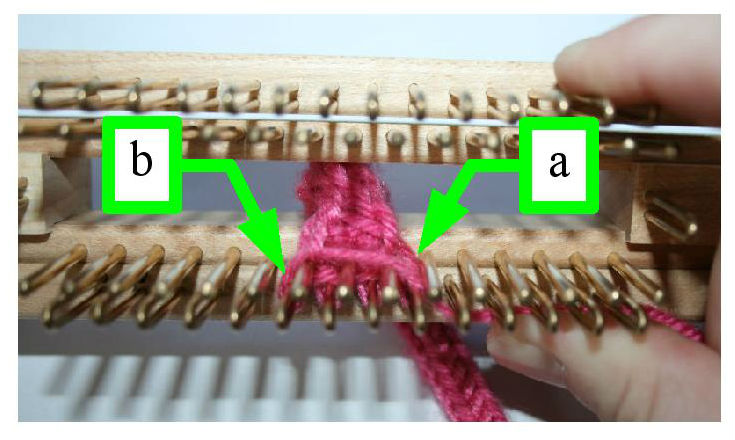
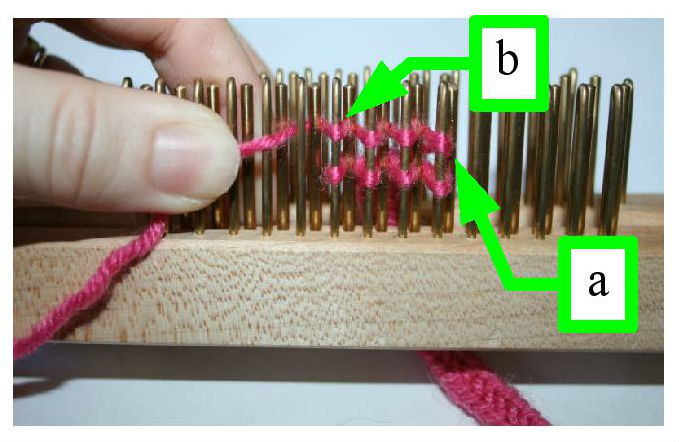
The main thing to remember is to work in small increments and that if you don't like it you can always change it. The face is an important feature and you need to be happy with the results. Sometimes it takes a few tries before you get one you like.
There are a few different methods for putting the eyes on. There are some great resources for this online too. I highly recommend taking a look at Mochimochi Land for a thorough tutorial (mochimochiland.com/2008/07/eye-eye-a-tutorial/)
First sew an outline using the back stitch method described in the notes section. Once the outline is done, begin filling in the middle of the eye ball a little bit at a time until the white is gone.
For the brow of Olaf it is best to use the sewn back stitch method. You can find many videos online that show this method really well. Although the example below is for a tiger mouth the idea is just the same. Let's say you are forming the brow right to left. First you will bring the yarn up at the location you want the brow to start (S) then bring it down two stitches over to the left (a) and underneath two more stitches to the left (b). You then bring the needle down through the hole of the previous stitch (a) filling in the line you missed and underneath 4 stitches to the left (c). Continue in this manner until the brow is formed. It is important to keep the stitches the same length.
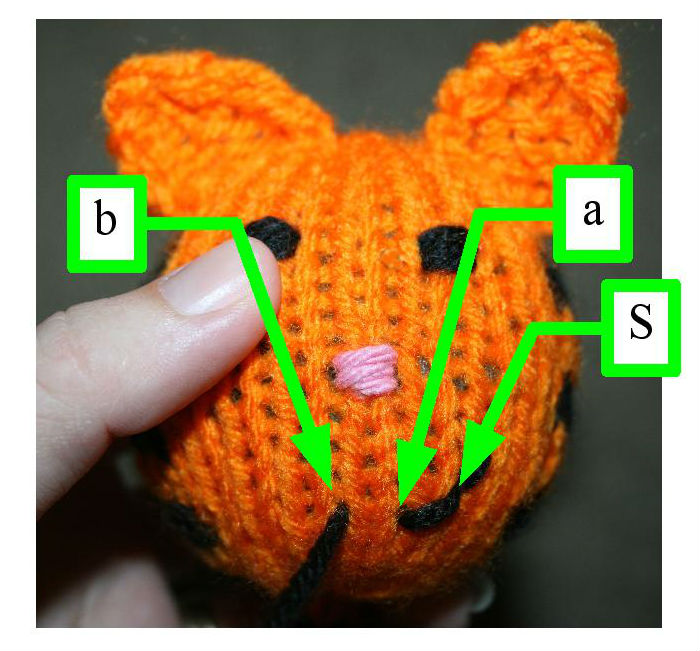
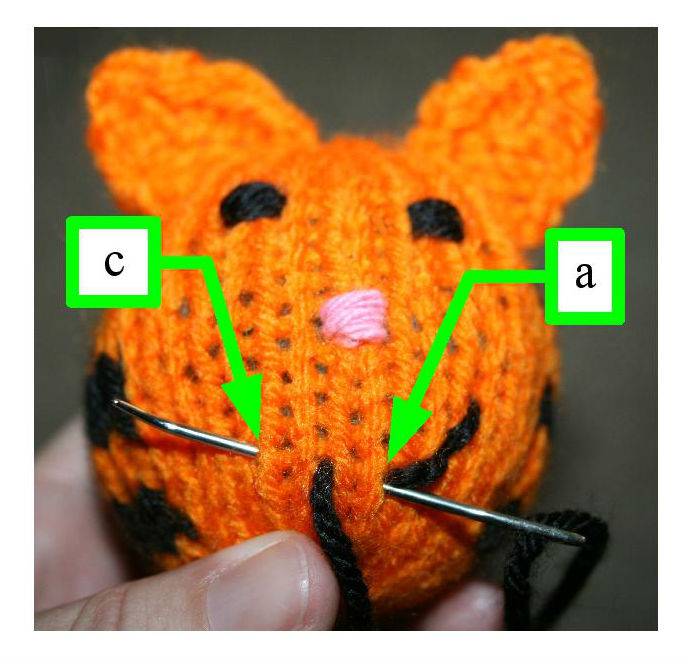
Striped Rows Hat
Striped Rows Hat
by Susan King ©2015
This beautiful hat was created on the new Large Gauge Dragon loom by Facebook Kiss Club member Susan King. This is Susan's first pattern and we think she's really learned to tame her Dragon! Congrats Susan on a job well done, you've created a winner!
Inspired by Charity Windham’s Bulky Striped Slouchy Hat
This simple hat is super quick to knit on the Kiss Dragon loom and works up great in self-striping yarn. For my hat, I used yarn from a mill ends bag. The yarn is most likely Charisma in the Sunny Day colorway, which is classified as #5, Bulky. The gauge is 10 stitches and 24 rows = 4” in the pattern stitch. I made my hat approximately 9” long before beginning the cast off.
To make this hat, you need to be able to do the knit stitch and the purl stitch on the Dragon loom. I set my loom up for 36 pegs because I wanted to use a ribbed brim, so I wanted it to be a bit smaller than it would have been using all 42 pegs of the Dragon. I cast on using Kate Winslow’s (The Answer Lady) long tail cast on. The video for this cast on can be found here.
After completing the cast on, I began the brim of the hat. I did a 2X2 rib stitch for the brim. Translated, that simply means that I knit two stitches then purled two stitches for each row of the brim. Since 36 divides nicely by 4, the ribs turned out very well, and one row ended where the next began. I did 10 rows of K2, P2 for the brim.
After completing the brim, I knit every stitch for 5 rows.
For the second group, I purled every stitch for 5 rows.
I repeated this 1 time, for a total of 2 sets, then I knit the last 5 rows. This made the hat about 9 inches long. If you want more ‘slouch’ to your hat, you could add another repeat of the knit 5 rows, purl 5 rows group.
To bind off the hat, I used Jeannie Phillips Flat Drawstring Cast Off, the video for which can be found here.
The hat is nice and stretchy and the Charisma yarn has a nice drape, making the hat very soft, and comfy. My head measures 22”, and the hat fits me nicely. If I were going to use a heavier yarn, I would go with more pegs.
Regular Peg Adjustable Videos
Welcome to our Regular Peg Adjustable Kiss Loom video section. These videos will work for our regular 2 way adjustable looms as well as our regular peg modular looms.
While all of our looms work in the same way we are dividing the videos up into the style of loom used so that you can easily find and see the information you are looking for. Please be sure to check out the other loom videos on the loom specific video pages.
Bind Off's
E-Wrap Cast On - a loose/loopy cast on.
Non Loopy/Double E-Wrap Cast On - a stretchy cast on perfect for most things, pairs nicely with the super stretchy bind off.
Long Tail Cast On
Knit Stitch/U-Wrap - forms the traditional v-shaped knit stitch. Tighter stitch then the e-wrap, a little looser then the traditional knit stitch (aka - reverse purl). Allows for the continuous knit stitch when used on the Kiss Looms - in other words - you can knit the entire row before knitting off.
Purl Stitch - forms the traditional horizontal purl bump on the front side of your knitting. There are 3 purling videos in this series. The first one has more instruction but #2 has some very helpful camera angles and #3 will cover the continuous purl stitch. I encourage you to watch all three so as to get really comfortable with purling.
Ribbing - K1 P1
Seed Stitch - row 1 is k1, p1, k1, p1. Row 2 is -p1, k1, p1, k1.
Garter Stitch - used as border stitch as well as an all around fabric stitch. When used as a border will keep the edges of your fabric from rolling.
Creating non-roll fabrics
Creating a Flare with 2-Color Short Rowing
Two Stitch Trim
Designing the Perfect Scarf
What Loom is Best for Me?

Here at Kiss Looms we know that deciding what loom to get is a big decision and you want to make sure you are looking at the right looms. To help make this easier we've put together a questionnaire of sorts to help you decide. You are welcome to also email us at any time with any questions - This email address is being protected from spambots. You need JavaScript enabled to view it.
Our product list can be viewed on the left hand menu bar by type of loom.
Another question we often get is "What is the biggest panel I can make with this loom" - to see how we figure that out click here.
The following are great ways to help you figure out what loom you'd like to purchase. Click on the options under the heading to see what options will work.
By yarn weight, I like working with:
Lace weight yarn
Sock yarn #1 or #2
Sport weight #3 up to super bulky yarn
By type of project, I like to make:
Socks
Small projects like scarves and hats
Medium projects like lapghans and baby blankets, kids clothing
Large projects like afghans and adult sweaters
Queen or king sized blankets
I'm not sure – all kinds of projects!
On the go projects - looms that travel easy
By technique, I like to do:
Double knitting
Weaving
Increase/decrease in the round
By ability, I have trouble:
With vision
With hands
With arthritis
For lace weight yarn we recommend using either the F0, which is our extra fine gauge loom with no pins, just pegs, or the F1 fine gauge loom. The F0 gets an average of 7-8 stitches per inch. The F1 gets an average of 6 stitches per inch. Those averages are based on sock weight yarn.
The F0 and F1 come in a few sizes - short and what we like to call the "classic" 11" loom. The classic has more than enough pegs to do adult sized socks, even Christmas stocking sized socks! Both also have the option of adding short or long end pairs. If you are wanting to do a shawl or sweater panel you may want to get the classic and add long end pairs to have enough pegs. The F1 also has long sides available. These are great when wanting to knit large sweaters, shawls or blankets. The long sides need to have at least the small end pair to connect them for knitting in the round.
For more information and to see our F0 and F1 looms click here!
There are several options for you here. Our F0 extra fine gauge loom will give a nice tight stitch using sock weight yarns, on average 7-8 stitches per inch. The F1 fine gauge loom will be a little looser but still no "holey" socks (average 6 stitches per inch). The F2 loom is best with thicker sock yarn or even sport weight yarn for thicker socks (average 5.5 stitches per inch with sock yarn and 5 stitches per inch with worsted).
These fall under our fixed gauge looms. What this means is that you can adjust the number of pegs you use in the round to make any size tube or sock size by moving the sliders back and forth across the sides to change the number of pegs to knit. This loom is not gauge adjustable like our other looms.
The F0, F1 and F2 come in a few sizes - short and what we like to call the "classic" 11" loom. The classic has more than enough pegs to do adult sized socks, even Christmas stocking sized socks! These also have the option of adding short or long end pairs. If you are wanting to do a shawl or sweater panel you may want to get the classic and add long end pairs to have enough pegs. The F1 and F2 also have long sides available. These are great when wanting to knit large sweaters, shawls or blankets. The long sides need to have at least the small end pair to connect them for knitting in the round.
For more information and to see our F0, F1 and F2 looms click here!
Sport weight #3 up to super bulky yarn
Fixed 2 Loom
For sport weight and worsted weight yarn you have a couple options. The F2 will work with both of these yarns. The worsted makes a very tight knit, thick fabric, sport weight is also a good tight knit. The F2 is not a gauge adjustable loom, but you can adjust by number of pegs used when knitting in the round. The F2 is also good for thicker sock weight yarn. On average the F2 has 5.5 stitches per inch with sock yarn and 5 stitches per inch with worsted weight yarn.
For more information and to see our F2 fine gauge looms click here!
Small Gauge 2 Way Adjustable
The most versatile loom we have is the small gauge 2 way adjustable loom. It is great for sport weight up to super bulky. The small gauge knits the smallest possible gauge fabric of all our adjustable looms. It adjusts by number of pegs you can knit in the round by moving the 1 peg ends or 7 and 31 end sliders back and forth across the sides to change the number of pegs to knit. The second way it adjusts is by gauge. You can add washers between the peg and pin boards making each stitch larger and allowing more room for thicker yarns. The great thing about the pins is that they have a side effect of making nice even stitches and you can wrap the whole row with a u-wrap stitch before knitting off. Click here for a video on how to adjust the gauge of your looms.
The small gauge comes in short 30 peg, classic 60 peg, and 77 peg long looms. The 77 peg sides have 77 pegs per side for a total of 154 pegs. These sides need to be used with either the 7, 16 or 31 peg ends. All of these end pairs will work with any of the small gauge looms.
For more information and to see our small gauge 2 way adjustable looms click here!
Small Gauge Modular
We also have small gauge modular looms available in 20 peg pairs. The difference in these looms is that they are not adjustable by number of pegs in the round. You can put four of them together for a total of 80 pegs to work in the round or as a flat panel or you can add brackets and make a bigger loom for larger projects. Also these looms have all the corners on the outside, whereas on the 2 way adjustable looms the corners or at least one corner is always set in when knitting on few pegs. Typically this isn't a problem once you get used to the loom.
For more information and to see our small gauge modular looms click here!
Regular Peg 2 Way Adjustable
Another option for worsted weight to super bulky is the regular peg 2 way adjustable loom. This loom is similar in function to our small gauge loom but instead has pegs with the opening facing you. This peg orientation is most similar to other commercially produced looms that have a groove in front. Really there is no difference in the peg orientation other than the regular has a slightly bigger stitch count at 4 stitches per inch to the small gauge 4.5 stitches per inch. These looms are available in 20 peg short, 40 peg classic and 53 peg side looms. The 53 peg sides need to be used with either the 5 or 21 peg ends. All of these end pairs will work with any of the regular peg looms.
For more information and to see our regular peg 2 way adjustable looms click here!
Regular Peg Modulars
We also have regular peg modular looms available in many different peg increments. They are available in two board pairs as well as sets of four boards and a hat combo of various size boards perfect for making infant through adult sized hats. The difference in these looms is that they are not adjustable by number of pegs in the round. You can put the looms together in a lot of configurations. The sets come with corner brackets but the pairs do not. Straight brackets can be used to hook the looms end to end and corner brackets are available separately. Also these looms have all the corners on the outside, whereas on the 2 way adjustable looms the corners or at least one corner is always set in when knitting on few pegs. Typically this isn't a problem once you get used to the loom.
For more information and to see our regular peg modular looms click here!
Small projects like scarves and hats
Small projects can be made on all of our looms. The short looms and classic length looms are great for small projects. You can always add bigger ends on the short looms for larger projects as well. Just remember you can knit on the looms in the round or as a flat panel using any number of pegs. If you are knitting flat panels, all of our looms can be used as single rake looms. For instance on our 2 way adjustable looms we provide you with a package of shorter nuts and bolts so that you can use each side of the loom independently from each other. These nuts and bolts are also needed for the sides when using the end pairs with the looms.
Hats
Our 2 way adjustable looms can knit any size tube in the round by moving the 1 peg ends or 5, 7, 21 and 31 end sliders back and forth across the sides to change the number of pegs to knit. If you are making hats you will need 72 pegs for an average adult hat, 54 pegs for kids hats, 48 pegs for baby hats, and 42 pegs for newborn hats.
What this means is, if you choose a loom with 72 or more pegs then you will be able to make all sizes of hats by moving the sliders up and down your boards. These numbers are based on using either the regular peg 2 way adjustable loom or the small gauge 2 way adjustable. Depending on how many washers you use it will make the hat bigger or smaller, with a looser or tighter stitch. On both looms you will need end pairs to have the needed 72 pegs. It also helps to have these if you are wanting to turn the brim of a hat as it allows more room in the middle to pull the fabric up properly to rehang it.
Hats can also be made on our fixed looms as well. It is best to make a swatch and see how the fit will be before proceeding with the actual pattern. For example 74 pegs for an adult hat on the regular 2 way adjustable will average an 18.5" diameter hat before stretching, the F1 with 74 pegs will average a 12.3" diameter hat. Since the gauge is much smaller more pegs will be required to equal the same size hat.
Our regular peg modular loom has a hat combo that includes the necessary boards to make infant through adult sized hats. With this set you can also make baby booties, a baby blanket and baby sweater! This set includes a 6 peg modular set with corner brackets, 9 peg modular pair, 15 peg modular pair and 2 pr of straight brackets along with all bolts and washers needed.
For more information and to see our regular peg modular hat combo click here!
Medium projects like lapghans and baby blankets, kids clothing
To make medium sized projects like lapghans and baby blankets or kids clothing you will need to determine what size panel you would like to make. For clothing this is easy - get a shirt and measure from one seam to the other on the front at the widest point. This will tell you the panel size. My 7 year old's youth medium shirt panel size is 17" wide. My 3 year old's toddler medium is 12". So for the kids sizes you will need 77 pegs for the youth medium and 54 for the toddler medium (3T) size based on 4.5 stitches per inch on the small gauge loom. The regular peg loom has 4 stitches per inch and will need fewer pegs to make the kids clothing - 68 and 48 pegs. Now this is based on average stitch count using worsted weight yarn. Your actual gauge might be different and you always need to swatch before beginning a project, especially clothing! To determine your panel size click here.
So for these projects you could use the small gauge 2 way adjustable with 60 pegs along with the 16 peg ends for a total of 90 pegs or the regular 2 way adjustable with 40 pegs and 21 peg ends with 80 total pegs. The modular looms of either type would also work for these projects.
If you are wanting to use sock weight yarn and one of our fixed looms you will again need to determine panel size needed. Remember to always go a bit larger as you will need to seam the sides and don't want to lose width when you do.
When counting how many pegs to use and adding end pairs make sure you subtract the number of pegs on the slider from your count. For example on the regular and small gauge there is a 1 peg slider on each end so the 60 peg loom has 58 pegs on the sides. The fixed looms have 3 peg ends.
For baby blankets there are various sizes you could do, and it all depends on what you want and how much yarn you have. There is a really good website that we found that has updated 2014 sizes for blankets. You can view the website here - http://craftingwithstyle.blogspot.com/2008/03/afghan-blanket-sizes.html. Let's look at the infant - 2 year size of 24" x 30". For this blanket you could use the small gauge 2 way adjustable loom with 60 pegs and the 31 end pair for a total of 120 pegs. If you used all pegs you would have a panel 26.6" wide. If you add washers the blanket will be larger. For larger blankets you would need the long sides and at least a small end pair or the larger modular pieces.
Large projects like afghans and adult sweaters
For larger afghans and adult sized clothing you will need the long sides on our fixed looms, regular and small gauge 2 way adjustable looms and either the short or long end pairs. The best way to determine which loom is to determine how big a panel the loom will make and if that will work for the projects you have in mind. To determine what size panels our looms will make click here.
I often get the question about making a queen or king size blanket in one panel. There's no right way to answer this question really, so here are some points to consider if this is what you are wanting to do.
If you are a new loomer (less than a year) a blanket this large is not something you want to try to accomplish in one panel. It takes a very long time and is very heavy while knitting. It can be a very daunting project and discourage you from pursuing this craft and we want you to have fun and enjoy this hobby.
Kiss modular looms are the only looms we have that can make a blanket this large. You will need several of the largest modular sets to have enough pegs. This loom set up is expensive for a first loom and very large and needs a permanent location until the project is finished. As mentioned above, this can take a long time.
The best way to make a blanket is in panels for a few reasons. One is that you feel like you are progressing in the project when you finish a panel. Panels also don't require a large loom or take as much time. Many knitters, especially newer loomers don't want to tackle seaming and that is why they wish to knit in one panel. The truth is, you will eventually need to seam something!  So it is best to study and practice till you are good at it. You won't regret it! Knitting the panels also gives you time to build up your confidence towards seaming.
So it is best to study and practice till you are good at it. You won't regret it! Knitting the panels also gives you time to build up your confidence towards seaming.
If you do decide to go ahead and pursue smaller panels for your blankets I would still recommend getting our long loom sides. If you are wanting to knit on the finer gauge looms keep in mind - smaller stitches also means more time knitting. If this is your first blanket go for the small gauge 77 sides and either 7 peg ends or 31 peg ends. This is a great all-around loom for larger projects and one of my personal favorites (Kelly).
For more information and to see our small gauge 2 way adjustable looms click here!
I'm not sure – all kinds of projects!
If you are not yet sure what kind of project you'd like to make my best recommendation is to get the small gauge 2 way adjustable loom. This is the most versatile loom we have. The classic 11" with 60 peg and the 7 peg ends will give you what you need to do adult sized hats as well as many, many other projects. This will give you a nice basic starting place that you can build on later.
For more information and to see our small gauge 2 way adjustable looms click here!
If you are looking to try our looms with a smaller investment I would recommend the 6 peg modular set with 24 pegs or getting either the small gauge short 30 peg loom, or the regular short 20 peg. Any of these looms can be added to in the future to make larger looms by using larger modular pieces and straight brackets or by adding larger end pairs on the 2 way adjustable looms.
For more information and to see our regular peg modular looms click here!
For more information and to see our 2 way adjustable looms click here!
On the go projects - looms that travel easy
The most portable of our looms are the short looms. They are about 7" long and will easily fit in a purse or travel bag. Our classic length are 11" long so they are also fairly portable and easy to use in the car (as long as you aren't driving, of course  ). Are short end pairs are small at approximately 6" long.
). Are short end pairs are small at approximately 6" long.
All of our 2 way adjustable looms can be used for double knitting (where the front and back of the fabric are identical and the fabric is twice as thick). Double knitting is done by removing the pin boards entirely and only using the peg boards and either washers or the 1 peg ends as spacers. This setup will work like the commercial long looms but have a lot more stabilty as well as gauge variation.
The modular looms can also be used for double knitting. To do this you will also need our modular double knit kit. I recommend using longer modulars instead of bracketing smaller ones for this. Remove the pin boards as mentioned above and use the double knit kit with brackets to space the peg boards apart. See the How to Assemble Kiss Modular Looms tutorial page 9 for more information on setup.
Kiss Looms can also be set up for weaving. In particular, the modular looms are ideal for this. There are many who have ventured into weaving on the Kiss, but at this time we can not offer teaching and support in this area. If you are interested in helping us to explore and develop this area of our looms please contact Kelly at This email address is being protected from spambots. You need JavaScript enabled to view it..
Increase/Decrease in the Round
The 2 way adjustable looms are perfect for increasing and decreasing in the round. Our 1 peg sliders or short and long end pairs are made to slide up and down the board for just this reason! Whether you are doing a sweater in the round or decreasing down for the crown of a hat, the 2 way adjustables are the looms for you.
If you have limited or no sight and would like to try our looms we recommend the regular peg modular looms. All of the corners are outside edges that will be easy to feel your way along to knit. The regular pegs with the opening towards the front also make it easier. If you have any questions or troubles you can email us at any time at This email address is being protected from spambots. You need JavaScript enabled to view it..
Our looms are very light - typically under 1 pound. So they are easy to handle. Another thing that can help is our loom lap stand. The stand supports the loom so that you can use one or both hands to knit. The modular looms will probably be the best option with all the corners on the outside. The stand will hold up to the 30x30 modular set (120 pegs).
We have had several loomers tell us that they were long time needle knitters until they started having problems with arthritis. Once they decided to try loom knitting they have noticed that they can knit with little to no pain. This is what one of our customers had to say about Kiss Looms:
Your design is incredible! I wasn't even able to knit on a KK loom. It was just too hard on my arthritic fingers. But with my F2, I have no pain at all no matter how long I knit. I haven't been able to knit for years and now I can again. I'm thrilled. I think it's been nearly ten years since I was able to knit so you can probably imagine how excited I am to have this in my life again. - Linda
You can figure out what the panel size will be based on our average stitches per inch. Take the number of pegs divided by the average stitch count and that will give you a good idea of the size. Of course when it comes down to knitting your project you always need to do your own swatch with your yarn to double check your actual gauge.

Regular Peg Videos
Welcome to our Regular Peg Kiss Loom video section. These videos will work for our regular peg modular looms as well as our regular 2 way adjustable looms.
While all of our looms work in the same way we are dividing the videos up into the style of loom used so that you can easily find and see the information you are looking for. Please be sure to check out the other loom videos on the loom specific video pages.
E-Wrap Cast On - a loose/loopy cast on.
Non Loopy/Double E-Wrap Cast On - a stretchy cast on perfect for most things, pairs nicely with the super stretchy bind off.
Long Tail Cast On
Drawstring Cast On
Knit Stitch/U-Wrap on the Modular Looms - forms the traditional v-shaped knit stitch. Tighter stitch then the e-wrap, a little looser then the traditional knit stitch (aka - reverse purl). Allows for the continuous knit stitch when used on the Kiss Looms - in other words - you can knit the entire row before knitting off.
Knit Stitch/U-Wrap on the Regular 2 Way Adjustable - forms the traditional v-shaped knit stitch. Tighter stitch then the e-wrap, a little looser then the traditional knit stitch (aka - reverse purl). Allows for the continuous knit stitch when used on the Kiss Looms - in other words - you can knit the entire row before knitting off.
Purl Stitch - forms the traditional horizontal purl bump on the front side of your knitting. There are 3 purling videos in this series. The first one has more instruction but #2 has some very helpful camera angles and #3 will cover the continuous purl stitch. I encourage you to watch all three so as to get really comfortable with purling.
Purl Stitch #2
Transfer Bind Off
Back Stitch Bind Off
Projects
Basic Hat Knit a Long using 2 6-peg modular looms with 2 pair of brackets
Click the titles to view the pdf tutorials in your browser or right click and select "save link as" to download them.
How to use a Kiss Loom featuring the Regular Modular Looms - this tutorial goes over the e-wrap, double e-wrap, u-stitch, and purling.
Videos
While all of our looms work in the same way we are dividing the videos and written tutorials up into the style of loom used so that you can easily find and see the information you are looking for. There are also video pages showing cast on's and bind off's on various looms, but the wrapping is identical no matter which loom you are using.
If there is a technique-specific video you'd like to see please email us at This email address is being protected from spambots. You need JavaScript enabled to view it..
Regular Peg Modular Kiss Loom - includes the 6 peg modular or any other sizes of modular looms.
Regular Peg Adjustable Kiss Loom - these are regular 2-way adjustable slim looms.
Small Gauge Compact Peg Adjustable Kiss Loom - these are the turned peg small gauge 2-way adjustable slim looms and the 20 peg small gauge modular looms.
Fixed 1 & 2 Kiss Looms - these are fixed fine gauge sock looms with pegs and pins on the same board.
Fixed 0 Kiss Looms - these are extra fine gauge looms with pegs only.
Basic Tips & Techniques - videos that include a variety of looms with various tips and techniques. Really great video selection!
Classic Kiss Videos/pdf instructions - these are older videos from the original tutorials page.
Cast On's - cast on techniques shown on various looms.
Bind Off's - bind off techniques shown on various looms.
Weaving Looms - videos for triangles and rectangles.
How do the Pins Work? -We often get questions about how our pins work and how the fabric can flow down. I hope this video helps you!
For additional videos please visit:
The Answer Lady- Our own Kathryn Doubrley presents us with lots of videos on various looms with different stitches and techniques, including a few loom a long videos.
The Vintage Storehouse - loom knitting stitchionary! Lots of videos with different stitch patterns.
Kiss Loom Lap Stand

The stand holds your loom so that you have both hands free to hold your yarn and pick. Just knit the side facing you then lift the loom up and turn! The square part tilts forward and backward to give you the ability to set it to your most comfortable knitting position. The stand is especially good for those with physical limitations that may need extra help holding the loom so that they can knit.
There is 13 3/4" between the legs at the smallest setting and approximately 22" at the widest setting. The stand sits 11" high (measured from the bottom of the legs to the bottom of the dowel rod). If you are interested in a wider or taller stand please email 
We have put together a complete list of what looms will work on the stand and which ones will not so that you can know if your looms will fit. To see the list - click here. For assembly instructions - click here.
For any questions email This email address is being protected from spambots. You need JavaScript enabled to view it.
Price: $59.95 plus shipping
Loom Stand Kit includes frame, yarn guide and all mounting hardware (4 "L" brackets, screws and 4 U-bolts).
Have more than one project going at a time? You can add another set of slats and brackets to your stand for ease in changing projects.
 Slat/Bracket Add On
Slat/Bracket Add On
$14.00 plus shipping
Includes 4 "L" brackets and 2 slats.

U-Bolt Add On
$6.00 plus shipping
Includes 4 U-Bolts for use with 2-Way Adj looms, will also need additional slats for use.
Kiss Looms is home to the 2-Way Adjustable Gauge Loom! Our looms were designed with the Kiss principal in mind. Keep it simple! Our looms allow you to change your gauge for any project, while still using the same loom. Knit with sock weight yarn using our fixed gauge looms or get an adjustable loom to knit from sport weight to super bulky!
Any questions? Not sure what loom to get? We love helping you with suggestions.Feel free to email us at: orders@kiss-looms.com
